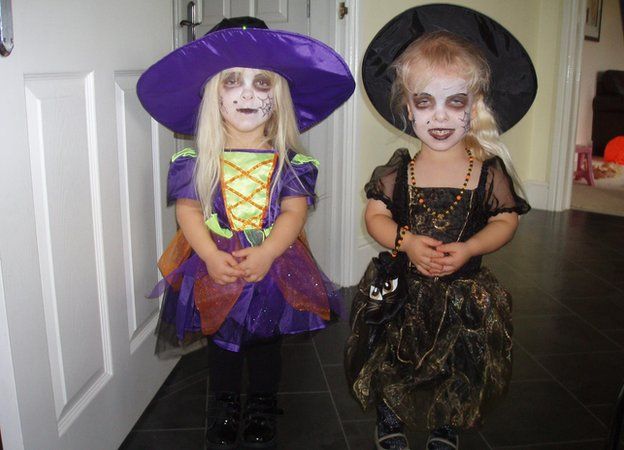Tips for a disability-friendly Halloween
- Published

Traditionally Halloween is an occasion for children to dress up in colourful costumes, but what extra considerations are there for families with disabled children?
Beyond deciding which houses to trick or treat at and what face to carve into the pumpkin, families with children who have autism, learning disabilities or physical differences have more to consider when it comes to Halloween. But they know from experience how to get around untypical body shapes, the importance of routines, and special diets to make it work and still have fun. Here are some tips for getting the most from the occasion.
Be prepared
This is particularly true for some children on the autism spectrum, for whom routine is all important. Like all other changes to their daily schedule, 31 October has to be anticipated and planned for well in advance. "One way you can do this," says blogger Jane McDowell, "is to have a calendar, and count down the days to Halloween with your child." McDowell writes the Ask-Pergers blog with her son Paddy-Joe, about life on the autism spectrum. If the child likes to know as much as possible about everything, she says, "it can be really helpful for them to learn lots of facts about Halloween such as where it originated from, and why it is still celebrated today."
Explain why people wear costumes
"My children used to be scared of masks and anyone dressed up," says Claire Ryan, who has a son and two daughters on the autistic spectrum. "So we talked to them about dressing up and that the person underneath stayed the same, that it was just how they looked that changed."
The Ambitious about Autism patron says that letting her children dress up at other times of the year in outfits of their choice also helped them to understand the costume concept.
Children with sensory issues can find certain materials and labels scratchy or uncomfortable. The same goes for wigs, masks and face paints. Getting a costume early allows children to get used to how it feels against their skin. Ryan's children sometimes wear pyjamas underneath. Alternatively, say the McDowells, "make a costume from clothes that the child is used to wearing so they feel more comfortable. For example, take old leggings and a T-shirt and tear them to make a zombie costume." If wearing masks is troublesome, they say, "use one on a stick that they can hold in front of their face as and when they want to."
Could the disability be part of the costume?
US motivational speaker and soccer player, Josh Sundquist, takes advantage of his unique body shape when designing his now famous Halloween costumes. As an amputee, he says he avoids the "obvious ones like shark attack victim or pirate". In 2013 he dressed up as a flamingo with his one leg acting as the bird's neck and bill.
Sundquist wasn't always so confident. His top tip is to make sure that the child is "in a place psychologically where they are comfortable expressing their disability through a costume".
He lost his leg to cancer as a child and said that back then he wore a prosthesis all the time and was "scared that people would find out I have one leg. Now I'm at a point later in life where it is part of who I am and my costumes celebrate it."
Twins of restricted growth Amelia and Imogen Hall love every aspect of Halloween, especially getting dressed up. "The girls are nine, but we might get them something from the three to four age group," says Dad Phil on finding things to fit. "This year they've picked Morphsuits (all-in-one bodysuits), which are a bit long for them in the arms and legs." He says that even though he and his wife warned the twins that the costumes might be a bit big, "they love them and they look very cute in them."
Hall's top tip is to give children choices. He says that the family doesn't "necessarily steer clear of" traditionally small character costumes like elves but, he says, "Amelia and Imogen just want to do everything that any other child will do, irrespective of restricted growth, so we try to make everything as normal as possible. And if they wanted to dress as a Minion from Disney's Despicable Me? Then fine," he says.
When it comes to trick or treat, be flexible
Daisy Nimmo has physical and learning disabilities and major health problems. Her mum Steph says that it's important to let friends and neighbours know that it's OK to call because "Daisy can't go out but she loves to answer the door in costume and hand out sweets." In their street, a pumpkin left on the doorstep indicates that the occupants are happy to accept trick or treaters. Their plan for this year is to carve a wheelchair symbol into Daisy's pumpkin.
As a mother of a child on the autistic spectrum, Claire Ryan says it's important that children aren't forced into participating in Halloween frivolities. "Let your child engage with Halloween at their pace in their own time," she says. "They may never want to take part and planning a different activity to do on that day and evening could be a much happier and calmer experience for all involved."
Email your tips for doing Halloween with disabled children to ouch@bbc.co.uk and we will update throughout the day.
Follow @BBCOuch on Twitter and on Facebook, and listen to our monthly talk show